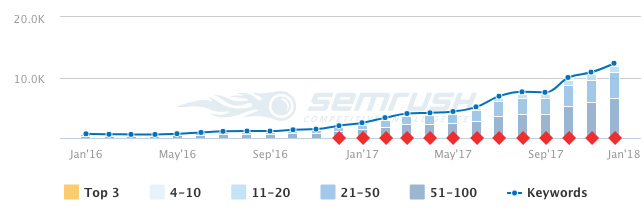Another year is upon us and looking back on this past year, we’ve once again been heads-down digging in to client requirements and our own internal tools and not practicing what we preach (though we did manage to squeak out an updated website). While SEO in general seems to be in a state of constant flux, we’ve continued to see great performance across the board, some clients faring better than others and while we’ve seen more consistent updates from Google throughout the year, our sustainable approach still works. When we’ve had full control over websites, we’ve seen much better results so we’ve been trying to figure out how to ensure that what we do can be scaled even when working with other development shops. This means that we need to ensure that at least the basics are taken care of, even when we can’t control every aspect of the campaign.
Many of the roadblocks in performance that we see have a fairly similar pattern but it always points to a shaky foundation. For whatever reason whether it be budget or inexperience or general incorrect decision-making the basics still continue to be elusive for many so we’ve spent a lot of time this year playing cleanup. We’ve also tried to make doing so, a more efficient process which allows us to reduce overall costs for clients and reducing the potential barrier to entry.
Generally budgets for small businesses and non profits are modest so being as efficient as possibly is necessary so we recommend a layered approach. While there are always shiny new objects to consider (mobile, voice, penguins, pandas, pigeons) the key practices generally remain the same. This practice has served us and our clients well through the years. Here are a couple of key elements that you might want to consider for 2018.
Set Your Foundation
Much like a house, you don’t want to be building on a shaky foundation. You’re asking for trouble down the road and most likely wasting your time. Getting these basics in place first ensures that you’re not facing an uphill battle getting visibility and best performance our of your web presence. Your website is at the core of this. We prefer WordPress but there are a bunch of other systems out there are can also form a strong foundation. Something like Wix will be an uphill battle from the start. Squarespace fares much better but still has limitations. We’ve done some other custom CMS options as well but we’re just comfortable with WordPress and as long as we can show results, we’ll stick with that.

Hosting – we’ve gotten incrementally better (and had to pay more mind you) through the years and finally this past year was one of our best performing and least headache-y years with Hosting. Our main objective is fast and reliable and beyond that we really prefer not to have to think about it. Our top tier WordPress hosting partnership through Pantheon has been a significant boon this past year and is well worth the price tag.
Data – it tells a story and helps direct the plot. Hopefully that plot is a good one. However, we’ve learned through the years that even if the data is there and available and accessible, it’s often overlooked. For some it may be a time thing. For others it may be too overwhelming or difficult to decipher so we’ve found the best thing for us is to keep an eye on it for our clients. This also has inherent issues mostly, when you’re watching so many clients through so many different tools you end up jumping all over the place, missing some, dwelling on others. This past year we have put a great deal of effort pulling together all of that disparate data and really leveraging it for our clients benefit. If you need something to hang your hat on, make it the most valuable element.

Iteration.
Website Management – if your website spent the whole year last year just sitting there looking pretty, that’s great but it probably means that it wasn’t working very hard for you. If you’re assuming the set-it-and-forget-it mode will end up paying dividends. Well, all the best. If you want it to truly perform to its potential then keep having a look at it. See how your visitors use it. What are others doing that might make your site more interesting or valuable to prospects? Making some small visual or layout adjustments can really have an impact on how customers both new and old view your company as well as Google.
Experimentation – Last on our list would be to invest in a little of testing. A couple of good options here would be to leverage Adwords which gives you more control over your traffic. Set a small budget to explore keywords, pages, conversion paths, landing pages…again options abound. A/B testing can also be leveraged to test out some messaging or design elements, layouts, images etc. If you need data before moving forward with changes, split testing can be very helpful.

Our iterative approach is really what makes the Internet such a thriving place. It’s a fluid environment that is constantly seeking new and useful things. Google also takes that approach, rewarding websites that provide value to users. Rewarding content that not only shows depth of expertise but content that is fresh and updated. For 2018, set your foundation then pay attention to it and you’ll be a much stronger contender than you were last year.





